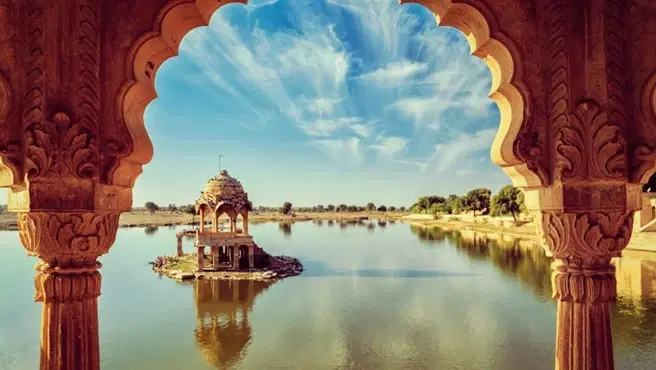
Flights
•05 min read

Jaipur, known for its vibrant culture and timeless architecture, captivates hearts with its rich history and global recognition as a UNESCO World Heritage site. This blog delves into the frequently asked questions about the Jaipur world heritage site number, explaining its significance and answering your queries about this iconic destination. By exploring Jaipur's historical landmarks and unique heritage, readers gain a clearer understanding of its legacy and the factors that make it an unmissable gem in Rajasthan.
A UNESCO World Heritage site number is a unique identifier given to places of immense cultural or natural significance. In the case of Jaipur, its designation is not only about numbering but signifies recognition of its unique urban planning, architectural marvels, and rich cultural tapestry. As the 42nd site recognized in India during an important milestone, this number reflects the city’s global importance and its enduring legacy in Indian history.
Declared as a UNESCO World Heritage site in July 2019 during the 43rd session of the UNESCO World Heritage Committee, according to official reports, Jaipur’s recognition marks an important milestone in preserving its splendor. This event highlighted the city’s celebrated landmarks and showcased its incredible journey from a mere city to an internationally acclaimed cultural hub.
Jaipur stands out because of its striking architectural beauty. The city’s iconic grid layout, established in the 18th century, and the prominent use of pink sandstone in its buildings have earned it the beloved nickname, the "Pink City." The regal ambience is further enhanced by globally revered sites like Jantar Mantar and the City Palace. These monuments not only signify architectural brilliance but also embody the creative genius that has defined Jaipur over the centuries.
This heritage status has bolstered the city's status as a major tourist destination, drawing visitors who wish to experience the rich confluence of art, history, and culture firsthand. With its vast spectrum of cultural heritage, Jaipur has become a symbol of progress and aspiration for travelers seeking a blend of modern convenience and historic charm.
Jaipur is home to some of India’s most celebrated heritage attractions. Prominent landmarks like the City Palace and Jantar Mantar are more than just tourist spots – they are gateways into the artistic and intellectual past of the city. These UNESCO Jaipur sites reflect the ingenuity of ancient architects and have continued to inspire generations with their architectural elegance and cultural significance.
*Did You Know? Jaipur’s World Heritage Status is a First for Urban Planning!*
Jaipur is the first planned city in India to receive UNESCO World Heritage Site recognition, thanks to its unique grid layout designed in 1727 by Maharaja Sawai Jai Singh II.
The cultural heritage of Jaipur is not just about bricks and mortar but is woven into local traditions and stories that have shaped its identity. The majestic architecture, along with vibrant cultural festivals, creates an enchanting narrative that captivates both domestic and international travelers. Many people explore these historic landmarks while experiencing the warm hospitality inherent to Jaipur, which truly embodies the spirit of India’s heritage.

Rajasthan is globally recognized for its concentration of historical landmarks. Jaipur, often seen as the epitome of this legacy, adds an essential chapter to the state’s rich collection of UNESCO sites. The number of UNESCO World Heritage sites in Rajasthan includes several acclaimed monuments such as Amber Fort, Jaisalmer Fort, and the Jaipur walled city. Each monument tells its own story of valor, art, and culture, making Rajasthan a hub of historical wealth.
Among these historic wonders, Jaipur is unique. Its urban planning reflects a brilliant blend of Mughal and Rajput influences, making it a living canvas of architectural innovation. The seamless integration of cultural traditions with progress and modernity makes Jaipur stand out among other heritage sites in Rajasthan. Its numerous cultural festivals, the charm of its markets, and the vibrant street life contribute to the city’s reputation as a melting pot of tradition and modern luxury.
There are a few common misconceptions regarding Jaipur’s heritage status that are worth clarifying. One frequent query is regarding the world-renowned Hawa Mahal. Although Hawa Mahal is indeed an iconic landmark, it is not listed as a standalone UNESCO site. Instead, it is an integral part of the larger heritage ensemble that comprises the entire walled city of Jaipur.
Another point of confusion involves the scope of Jaipur’s UNESCO recognition. The heritage status extends beyond a few select monuments to cover the entire historic expanse of the city. This comprehensive recognition encompasses not just individual attractions, but the entire urban fabric that gives Jaipur its iconic character. It celebrates the city’s holistic cultural legacy and architectural marvel.
The 42nd UNESCO World Heritage Site in India is the Jaipur walled city, recognized in 2019.
Rajasthan has several UNESCO World Heritage Sites, including renowned sites such as Jaipur, Amber Fort, and Jantar Mantar.

Jaipur is called the “Pink City” due to the pink sandstone used extensively in its historic architecture, symbolizing warmth and hospitality.
No, Jantar Mantar is a celebrated UNESCO site, but the historic walled city of Jaipur is also recognized as a part of this prestigious legacy.
Jaipur was declared a UNESCO World Heritage Site in July 2019 during the 43rd session of the World Heritage Committee.
Jaipur’s UNESCO recognition has significantly boosted its tourism appeal, drawing travelers from across the globe to explore its rich cultural and architectural legacy.
In summary, Jaipur’s designation as a UNESCO World Heritage site is a true celebration of its rich architectural and cultural heritage. The unique world heritage site number assigned to Jaipur marks a milestone in preserving its historical legacy and sets it apart as a beacon of urban planning excellence. Whether you are a history buff, a travel enthusiast, or someone who appreciates the beauty of cultural diversity, Jaipur offers an experience like no other. The city not only reflects the grandeur of India’s past but also inspires a journey towards progress and modernity.
For those planning their next trip, consider how seamless travel experiences — such as those provided by Tata Neu — can beautifully complement your journey. With options for booking premium flights via Air India and Air India Express, along with exclusive loyalty benefits like earning NeuCoins on your bookings (1 NeuCoin equals ₹1 saving), your travel becomes both rewarding and stress-free. Enjoying priority check-in and lounge access on select flights, along with personalized travel packages curated by experts, ensures that your journey is memorable from start to finish. The thoughtful integration of premium travel services emphasizes Tata Neu's commitment to making every trip a luxurious and enriching experience.
Embrace the spirit of Jaipur and explore the marvels of architecture and history that have enchanted generations. Let the warm hues, intricate designs, and fascinating stories of the city inspire your wanderlust and offer a glimpse into the legacy of India's cultural heritage. As you traverse the lively streets of the Pink City, allow yourself to be enveloped by an atmosphere of elegance, history, and unparalleled charm.